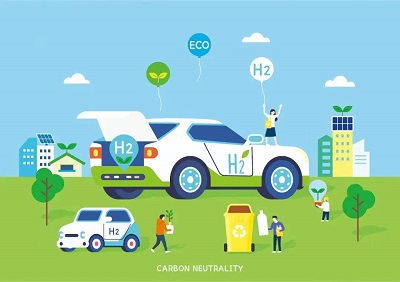For the high-quality development of hydrogen energy, experts call for “firm” technology!
Hydrogen energy and fuel cells have broad application prospects and are currently in the early stages of large-scale commercialization. The official launch of the country’s first batch of fuel cell vehicle demonstration cities will greatly accelerate the autonomy and commercialization of hydrogen energy and fuel cells.
Potential clean new energy
In addition to solar energy, wind energy and lithium batteries for energy storage, hydrogen energy is also a potential clean new energy
Under the goal of carbon peak and carbon neutrality, the development of the hydrogen energy industry has received much attention. At present, the hydrogen energy industry is in the early stage of industrialization.
The high-quality development of the industry is inseparable from continuous technological innovation and close cooperation of “government, industry, university, research and application”.

Under the goal of carbon reduction, in addition to transportation, hydrogen energy and fuel cells will also play an important role in industry, power generation, and civilian use.
As an integrated product, hydrogen energy and fuel cells are important innovations and applications in the future energy technology revolution, and will play a key role in emission reduction and energy structure transformation.
The essence of the carbon peak and carbon neutral goal is the reduction of carbon dioxide. The main sources of carbon emissions include industry, power generation, construction and transportation.
With the further development of industry, total carbon dioxide emissions will continue to rise in the next few years. It is an extremely difficult task to achieve a huge total carbon emission reduction in the shortest time.
The hydrogen energy industry chain is very long, including hydrogen production, storage and transportation, supply, and terminal applications. Whether it is fuel cell vehicles, airplanes, unmanned aerial vehicles, power generation, and civilian applications, there is a very broad application space.
With the further increase in the demand for renewable energy, hydrogen energy will also play a key role in it. The combination of renewable energy and hydrogen energy can effectively suppress the shortcomings of intermittent and seasonality and ensure the production of high-quality electricity; at the same time, the hydrogen produced by electrolysis of water can not only be used for energy saving and emission reduction in the transportation field, but also can be used Industrial and other civilian fields.
In the context of carbon reduction, hydrogen energy can play a role in stabilizing energy supply, ensuring energy security and reducing carbon in multiple dimensions.
From the perspective of energy security, the partial replacement of oil and gas by green hydrogen can alleviate the problem of the safe supply of oil and gas fuel; from the perspective of carbon, hydrogen can help decarbonize, sequester, and even achieve carbon negative in many areas.
“Firm” technology
Experts call for a focus on “firm” technology
At present, there are many technical stages in the hydrogen energy industry chain from production, storage to application that require innovation and development.
The fuel cell vehicle demonstration city policy particularly emphasizes that the lack of core technologies and key components is an important direction that the industry needs to tackle closely. This policy will greatly promote the development of fuel cell industrialization.
However, objectively, the cost of renewable energy hydrogen production cost is high, and the green hydrogen-rich areas and application areas are seriously misaligned, resulting in high prices for green hydrogen production, storage and transportation.
Solar water electrolysis hydrogen production technology can realize efficient and clean resource recycling. Within five years, it is possible to embark on a path of industrialization and large-scale applications, and an energy system based on hydrogen and electricity will be formed in the future.
Facing the challenges of the cost, storage and transportation of the hydrogen energy industry chain, researches on ammonia as a hydrogen medium have begun at home and abroad. Ammonia is not only a hydrogen storage medium that is convenient for safe transportation, but also a renewable zero-carbon fuel.
However, the application of ammonia as a fuel also has technical challenges. For example, ammonia is difficult to ignite during combustion in an internal combustion engine and has a low calorific value, which requires further research to overcome.
In a sense, the R&D and industrialization of hydrogen production, hydrogen storage, and fuel cells are important directions for breakthroughs.
From the perspective of the entire fuel cell industry chain, this involves materials science, electronic engineering, vehicle integration and other fields. Therefore, the industrial development of fuel cells is not a simple material or application problem, but a systematic engineering. Any breakthrough in a single field cannot completely solve the bottleneck of industrialization.
At the same time, from upstream material research and development, industrialization to terminal applications, it involves multi-level engineering verification.
Close cooperation in these engineering verification processes is also very important. At the same time, it is necessary to strengthen the close cooperation of industrialization-oriented “government-industry-university-research and application” to promote the continuous technological progress of hydrogen fuel cells.
 +8613906047998
+8613906047998




